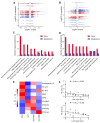Transcriptomic and Metabolomic Analyses Reveal the Attenuating Role of Cordycepin and Cordyceps militaris Extract on Acute Liver Injury Induced by LPS in Piglets
- PMID: 39409822
- PMCID: PMC11475243
- DOI: 10.3390/ani14192873
Transcriptomic and Metabolomic Analyses Reveal the Attenuating Role of Cordycepin and Cordyceps militaris Extract on Acute Liver Injury Induced by LPS in Piglets
Abstract
Cordyceps militaris extract (CME) contains many bioactive compounds, mainly cordycepin (CPN). This study aimed to investigate the possible mechanisms underlying the amelioration of LPS-induced acute liver injury in piglets by CME or CPN supplementation using multi-omics analysis. Twenty-four weaned piglets were randomly distributed into 4 groups (n = 6): the control and LPS groups were fed basal diets; the CPN + LPS (CPN-LPS) and CME + LPS (CME-LPS) groups were fed the basal diets supplemented with CME or CPN. The results showed that CPN or CME supplementation significantly decreased the C-reactive protein level (p < 0.05) and improved liver tissue pathology to prevent acute liver injury after LPS treatment. Compared with LPS, the transcriptomic analysis indicated that CPN supplementation significantly downregulated cell adhesion molecules, while CME supplementation significantly downregulated inflammatory mediator regulation of TRP channels, complement and coagulation cascades and cytokine-cytokine receptor interaction. The metabolomic results showed that CPN or CME supplementation significantly reduced disease biomarker of bicyclo-prostaglandin E2, and increased levels of deoxyinosine and 3-hydroxyanthranilic acid (p < 0.05). The combined transcriptome and metabolome helped identify two metabolites PC 34:2 and PC 36:0, which may be associated with the restoration of liver cell morphology. In conclusion, CPN and CME could attenuate LPS-induced acute liver injury by regulating immune-related genes and metabolites. This study elucidates the potential protective mechanism of CPN or CME supplementation against acute liver injury.
Keywords: Cordyceps militaris extract; cordycepin; liver injury; metabolomics and transcriptomics; piglets.
Conflict of interest statement
The authors declare no conflicts of interest.
Figures






Similar articles
-
Cordyceps militaris extract and cordycepin ameliorate LPS-challenged colonic damage in piglets by modulating the microbiota and metabolite profiles.Front Immunol. 2025 Mar 10;16:1530098. doi: 10.3389/fimmu.2025.1530098. eCollection 2025. Front Immunol. 2025. PMID: 40129987 Free PMC article.
-
Cordyceps militaris Extract and Cordycepin Alleviate Oxidative Stress, Modulate Gut Microbiota and Ameliorate Intestinal Damage in LPS-Induced Piglets.Antioxidants (Basel). 2024 Apr 8;13(4):441. doi: 10.3390/antiox13040441. Antioxidants (Basel). 2024. PMID: 38671889 Free PMC article.
-
Cordyceps militaris mushroom and cordycepin inhibit RANKL-induced osteoclast differentiation.J Med Food. 2015 Apr;18(4):446-52. doi: 10.1089/jmf.2014.3215. Epub 2015 Mar 19. J Med Food. 2015. PMID: 25789604
-
Amelioration of hyperuricemia by cordycepin and Cordyceps militaris aqueous extract in mice via modulating gut microbiota and restoring metabolic profile.J Pharm Biomed Anal. 2024 Oct 15;249:116368. doi: 10.1016/j.jpba.2024.116368. Epub 2024 Jul 16. J Pharm Biomed Anal. 2024. PMID: 39024793
-
System-level investigation of anti-obesity effects and the potential pathways of Cordyceps militaris in ovariectomized rats.BMC Complement Med Ther. 2022 May 12;22(1):132. doi: 10.1186/s12906-022-03608-y. BMC Complement Med Ther. 2022. PMID: 35550138 Free PMC article.
References
Grants and funding
LinkOut - more resources
Full Text Sources
Research Materials

